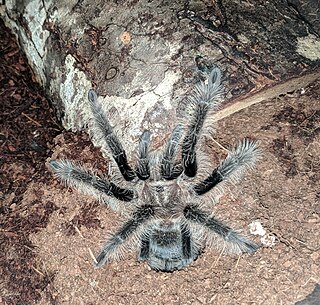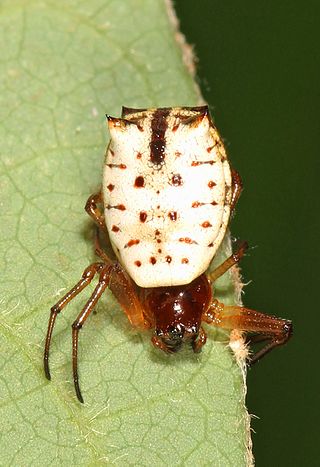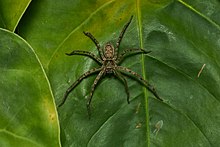
Latrodectus mactans, known as southern black widow or simply black widow, and the shoe-button spider, is a venomous species of spider in the genus Latrodectus. The females are well known for their distinctive black and red coloring and for the fact that they will occasionally eat their mates after reproduction. The species is native to North America. The venom can cause pain and other symptoms, but is rarely fatal to healthy humans.

Huntsman spiders, members of the family Sparassidae, are known by this name because of their speed and mode of hunting. They are also called giant crab spiders because of their size and appearance. Larger species sometimes are referred to as wood spiders, because of their preference for woody places. In southern Africa the genus Palystes are known as rain spiders or lizard-eating spiders. Commonly, they are confused with baboon spiders from the Mygalomorphae infraorder, which are not closely related.

Parasteatoda tepidariorum, the common house spider or American house spider, is a spider species of the genus Parasteatoda with a cosmopolitan distribution. Common house spiders are synanthropic and live in and near human dwellings. Their prey mechanism is similar to that of the other cobweb spiders: the spider follows disturbances transmitted along the web to entangle and then paralyze its prey, which usually consists of household insects and other invertebrates.

The Goliath birdeater belongs to the tarantula family Theraphosidae. Found in northern South America, it is the largest spider in the world by mass and body length, and second to the giant huntsman spider by leg span. It is also called the Goliath tarantula or Goliath bird-eating spider; the practice of calling theraphosids "bird-eating" derives from an early 18th-century copper engraving by Maria Sibylla Merian that shows one eating a hummingbird. Despite the spider's name, it rarely preys on birds.

The southern house spider is a species of large spider in the family Filistatidae. Currently given the scientific name Kukulcania hibernalis, it was formerly known as Filistata hibernalis. Found in the Americas, it exhibits strong sexual dimorphism. It lives in the southern states of the USA, throughout Central America and some of the Caribbean, to southern Brazil, Uruguay and Argentina. The males may be mistaken for brown recluses because the two have similar coloration and body structure. However, compared to the brown recluse, male southern house spiders are typically larger in size, lack the distinctive violin shape on their cephalothorax, and have unusually long slender pedipalps. The females are dark brown or black and more compact. Both sexes may grow to be roughly 2 inches (5.1 cm) across, with the males typically having longer legs, and the females often having larger, bulbous bodies. The abdomen of the southern house spider is covered with fine velvety light gray hair.

The spider species Tegenaria domestica, commonly known as the barn funnel weaver in North America and the domestic house spider in Europe, is a member of the funnel-web family Agelenidae.

Micrommata virescens, common name green huntsman spider, is a species of huntsman spiders belonging to the family Sparassidae.

Heteropoda is a genus of spiders in the family Sparassidae, the huntsman spiders. They are mainly distributed in tropical Asia and Australia, while at least one species, H. venatoria, has a cosmopolitan distribution, and H. variegata occurs in the Mediterranean.

Heteropodatoxins are peptide toxins from the venom of the giant crab spider Heteropoda venatoria, which block Kv4.2 voltage-gated potassium channels.

Tliltocatl albopilosus is a species of tarantula, also known as the curlyhair tarantula. The species' native range is Nicaragua and Costa Rica. They are largely terrestrial, opportunistically burrowing spiders.

Tarantulas comprise a group of large and often hairy spiders of the family Theraphosidae. As of December 2023, 1,100 species have been identified, with 166 genera. The term "tarantula" is usually used to describe members of the family Theraphosidae, although many other members of the same infraorder (Mygalomorphae) are commonly referred to as "tarantulas" or "false tarantulas". Some of the more common species have become popular in the exotic pet trade. Many New World species kept as pets have setae known as urticating hairs that can cause irritation to the skin, and in extreme cases, cause damage to the eyes.
Hysterocrates gigas is a member of the tarantula family, Theraphosidae found in Cameroon. It is known as the giant baboon spider, Cameroon red baboon spider, or red baboon tarantula.

The giant huntsman spider is a species of the huntsman spider family Sparassidae found in Laos. It is considered the world's largest spider by leg span, which can reach up to 30 cm (1 ft).

Heteropoda davidbowie is a species of huntsman spider of the genus Heteropoda. It was described from the Cameron Highlands District in peninsular Malaysia and named in honour of singer David Bowie.

Agelena labyrinthica is a species of spider in the family Agelenidae. It is a widespread species in Europe and its range extends to Central and East Asia.

Heteropoda cervina, commonly called the brown huntsman, is a large species of spider in the family Sparassidae often found in leaf litter in central Queensland, Australia. The species was first described by Ludwig Carl Christian Koch in 1875 as Sarotes cervinus.

Palystes is a genus of huntsman spiders, commonly called rain spiders or lizard-eating spiders, occurring in Africa, India, Australia, and the Pacific. The most common and widespread species is P. superciliosus, found in South Africa, home to 12 species in the genus. The name Palystes is derived from either the Latin palaestes or the Greek palaistes, meaning "wrestler". The genus was first described by Ludwig Carl Christian Koch in 1875.

Pisaurina mira, also known as the American nursery web spider, is a species of spider in the family Pisauridae. They are often mistaken for wolf spiders (Lycosidae) due to their physical resemblance. P. mira is distinguished by its unique eye arrangement of two rows.

Tachypompilus analis, the red-tailed spider wasp is a species of spider wasp found in most of tropical and subtropical Asia, north to Japan. These spider wasps often hunt huntsman spiders.

Micrathena mitrata, the white micrathena, is a species of orb weaver in the spider family Araneidae. It is found in a range from the United States to Brazil. The spider has a distinctive appearance with a shiny, black abdomen and spiky, yellowish-brown legs. Its body length ranges from 4 to 9 mm in females and 3 to 4 mm in males. The species is known for its elaborate web, which it uses to capture insects for food. Despite its fearsome appearance, Micrathena mitrata is not considered dangerous to humans and is generally regarded as a harmless spider.























